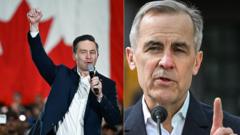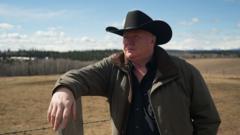In a climate of heightened tensions, particularly centered around U.S. relations, Canadians are presented with a polarized political narrative. The election atmosphere has dramatically shifted from a Conservative lead to a competitive race as Liberal rising star Mark Carney seeks to capitalize on the landscape's changing tides.
A Shift in Canada's Electoral Landscape: Liberal Successes and Conservative Challenges

A Shift in Canada's Electoral Landscape: Liberal Successes and Conservative Challenges
As Canada approaches its historic election, the political battlefield reflects stark contrasts between the parties vying for power.
At a rally in London, Ontario, Liberal leader Mark Carney confronted crowd hostility while framing threats from President Trump as a crucial part of his campaign. "President Trump is trying to break us so that America could own us," he warned, igniting responses from a crowd that rallied for Canadian sovereignty.
Conversely, Conservative leader Pierre Poilievre has gained significant traction with his calls for change, marking time for political transition. His rallies resonate deeply with Canadians feeling disillusioned after years of Liberal governance. "Bring it Home" has emerged as a rallying cry for a movement that emphasizes patriotism and national recovery in the wake of perceived U.S. aggression.
As election day approaches, the two parties appear almost neck-and-neck, despite an earlier Conservative surge. Polls indicate the Liberals are now within striking distance of the Conservatives, after many expected a straightforward victory for Poilievre.
Political observers have noted that unrest among voters has fueled interest in both major parties, especially in light of recent developments like Justin Trudeau's resignation and Carney's ascendance. Historically, upheaval in political domains often leads to a reshuffling of voter preferences, and Carney capitalizes on this refreshingly to position himself as pragmatic amidst an uncertainty-filled climate.
The wider implications of this election resonate far beyond party lines, as many Canadians fear for their economic stability, particularly in housing markets affected by years of Liberal policy. With a keen focus on issues like crime and healthcare, Poilievre appeals to Canadians seeking tangible solutions to these pressing concerns.
Unlike typical election rhetoric, where the conversation often drifts towards ideals and ethics, this election pivots heavily upon economic realities and the looming presence of a trade war with the U.S. As such, issues like climate change and immigration often recede into the background, complicating party identification for voters.
Ultimately, voter sentiment seems divided but equally poised for change; those disillusioned with the system are encouraged to shift allegiances. Strategically, the New Democratic Party (NDP) has urged supporters to consider tactical voting as a mechanism to ensure influence in governing powers—a sign of a fractured political landscape eager for innovation alongside profound discontent.
The election results remain highly unpredictable, with both parties presenting unique arguments for citizens about which direction to steer the nation, as Canada teeters at the crossroads of change and continuity.
With the stakes higher than ever, the outcome will likely redirect not only government policies but also the way Canadians envision their identity in a global context.
Conversely, Conservative leader Pierre Poilievre has gained significant traction with his calls for change, marking time for political transition. His rallies resonate deeply with Canadians feeling disillusioned after years of Liberal governance. "Bring it Home" has emerged as a rallying cry for a movement that emphasizes patriotism and national recovery in the wake of perceived U.S. aggression.
As election day approaches, the two parties appear almost neck-and-neck, despite an earlier Conservative surge. Polls indicate the Liberals are now within striking distance of the Conservatives, after many expected a straightforward victory for Poilievre.
Political observers have noted that unrest among voters has fueled interest in both major parties, especially in light of recent developments like Justin Trudeau's resignation and Carney's ascendance. Historically, upheaval in political domains often leads to a reshuffling of voter preferences, and Carney capitalizes on this refreshingly to position himself as pragmatic amidst an uncertainty-filled climate.
The wider implications of this election resonate far beyond party lines, as many Canadians fear for their economic stability, particularly in housing markets affected by years of Liberal policy. With a keen focus on issues like crime and healthcare, Poilievre appeals to Canadians seeking tangible solutions to these pressing concerns.
Unlike typical election rhetoric, where the conversation often drifts towards ideals and ethics, this election pivots heavily upon economic realities and the looming presence of a trade war with the U.S. As such, issues like climate change and immigration often recede into the background, complicating party identification for voters.
Ultimately, voter sentiment seems divided but equally poised for change; those disillusioned with the system are encouraged to shift allegiances. Strategically, the New Democratic Party (NDP) has urged supporters to consider tactical voting as a mechanism to ensure influence in governing powers—a sign of a fractured political landscape eager for innovation alongside profound discontent.
The election results remain highly unpredictable, with both parties presenting unique arguments for citizens about which direction to steer the nation, as Canada teeters at the crossroads of change and continuity.
With the stakes higher than ever, the outcome will likely redirect not only government policies but also the way Canadians envision their identity in a global context.



















